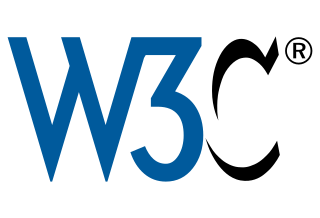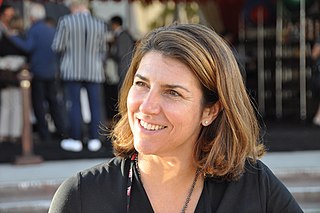
The HyperText Markup Language or HTML is the standard markup language for documents designed to be displayed in a web browser. It can be assisted by technologies such as Cascading Style Sheets (CSS) and scripting languages such as JavaScript.

Sir Timothy John Berners-Lee, also known as TimBL, is an English computer scientist best known as the inventor of the World Wide Web. He is a Professorial Fellow of Computer Science at the University of Oxford and a professor at the Massachusetts Institute of Technology (MIT). Berners-Lee proposed an information management system on 12 March 1989, then implemented the first successful communication between a Hypertext Transfer Protocol (HTTP) client and server via the Internet in mid-November.

The World Wide Web (WWW), commonly known as the Web, is an information system enabling documents and other web resources to be accessed over the Internet.

The World Wide Web Consortium (W3C) is the main international standards organization for the World Wide Web. Founded in 1994 and led by Tim Berners-Lee, the consortium is made up of member organizations that maintain full-time staff working together in the development of standards for the World Wide Web. As of 21 March 2022, W3C had 459 members. W3C also engages in education and outreach, develops software and serves as an open forum for discussion about the Web.

WorldWideWeb is the first web browser and web page editor. It was discontinued in 1994. It was the first WYSIWYG HTML editor.

Robert Cailliau is a Belgian informatics engineer, computer scientist and author who proposed the first (pre-www) hypertext system for CERN in 1987 and collaborated with Tim Berners-Lee on the World Wide Web from before it got its name. He designed the historical logo of the WWW, organized the first International World Wide Web Conference at CERN in 1994 and helped transfer Web development from CERN to the global Web consortium in 1995. Together with Dr. James Gillies, Cailliau wrote How the Web Was Born, the first book-length account of the origins of the World Wide Web.

The Line Mode Browser is the second web browser ever created. The browser was the first demonstrated to be portable to several different operating systems. Operated from a simple command-line interface, it could be widely used on many computers and computer terminals throughout the Internet. The browser was developed starting in 1990, and then supported by the World Wide Web Consortium (W3C) as an example and test application for the libwww library.

Nicola Pellow is an English mathematician and information scientist who was one of the nineteen members of the WWW Project at CERN working with Tim Berners-Lee. She joined the project in November 1990, while an undergraduate maths student enrolled on a sandwich course at Leicester Polytechnic. Pellow recalled having little experience with programming languages, "... apart from using a bit of Pascal and FORTRAN as part of my degree course."

The World Wide Web is a global information medium which users can access via computers connected to the Internet. The term is often mistakenly used as a synonym for the Internet, but the Web is a service that operates over the Internet, just as email and Usenet do. The history of the Internet and the history of hypertext date back significantly farther than that of the World Wide Web.

Erwise is a discontinued pioneering web browser, and the first available with a graphical user interface.
Giant Global Graph (GGG) is a name coined in 2007 by Tim Berners-Lee to help distinguish between the nature and significance of the content on the existing World Wide Web and that of a promulgated next-generation web, presumptively named Web 3.0. In common usage, "World Wide Web" refers primarily to a web of discrete information objects readable by human beings, with functional linkages provided between them by human-created hyperlinks. Next-generation Web 3.0 information designs go beyond the discrete web pages of previous generations by emphasizing the metadata which describe information objects like web pages and attribute the relationships that conceptually or semantically link the information objects to each other. Additionally, Web 3.0 technologies and designs enable the organization of entirely new kinds of human- and machine-created data objects.
This article is a summary of the 1990s in science and technology.

CERN httpd is an early, now discontinued, web server (HTTP) daemon originally developed at CERN from 1990 onwards by Tim Berners-Lee, Ari Luotonen and Henrik Frystyk Nielsen. Implemented in C, it was the first web server software.

Rufus Pollock is a British economist, activist and social entrepreneur. He has been a leading figure in the global open knowledge and open data movements, starting with his founding in 2004 of the non-profit Open Knowledge Foundation which he led until 2015. From 2007-2010 he was the Mead Fellow in Economics at the University of Cambridge and from 2010-2013 he was a Shuttleworth Foundation fellow. In 2012 was appointed an Ashoka Fellow and remains an Associate of the Centre for Intellectual Property and Information Law at the University of Cambridge and continues to serve on the board of Open Knowledge International. Since leaving Open Knowledge International, his work has moved to focus more on broader issues of social transformation and in 2016 he co-founded a new non-profit "Life Itself". However, he has continued to work actively on the economics and politics of the information age, including publishing "The Open Revolution: Rewriting the Rules of the Information Age" in 2018.
A Uniform Resource Locator (URL), colloquially termed a web address, is a reference to a web resource that specifies its location on a computer network and a mechanism for retrieving it. A URL is a specific type of Uniform Resource Identifier (URI), although many people use the two terms interchangeably. URLs occur most commonly to reference web pages (HTTP) but are also used for file transfer (FTP), email (mailto), database access (JDBC), and many other applications.
The Women's Technology Empowerment Centre (W.TEC) is a non-profit organization that provides technology education for women and girls in Nigeria. W.TEC offers services and programs including mentoring, training, technology camps, awareness campaigns, collaborative projects, and research and publication in order to empower women.
Solid is a web decentralization project led by Sir Tim Berners-Lee, the inventor of the World Wide Web, developed collaboratively at the Massachusetts Institute of Technology (MIT). The project "aims to radically change the way Web applications work today, resulting in true data ownership as well as improved privacy" by developing a platform for linked-data applications that are completely decentralized and fully under users' control rather than controlled by other entities. The ultimate goal of Solid is to allow users to have full control of their own data, including access control and storage location. To that end, Tim Berners-Lee formed a company called Inrupt to help build a commercial ecosystem to fuel Solid.

Contract for the Web is an initiative by the World Wide Web Foundation in November 2019 to attempt to address issues of political manipulation, fake news, privacy violations, and other malign forces on the internet.

Rosemary Blaire Leith, Lady Berners-Lee is a director of both profit and nonprofit organizations. Leith co-founded the World Wide Web Foundation together with her husband-to-be, Tim Berners-Lee in 2009.












